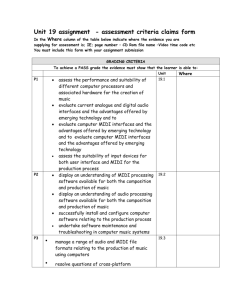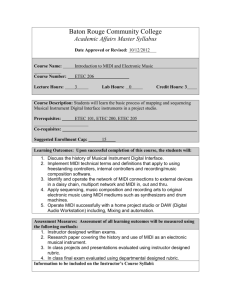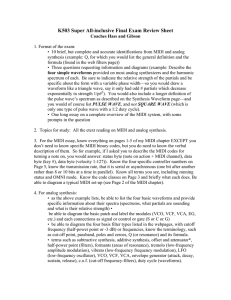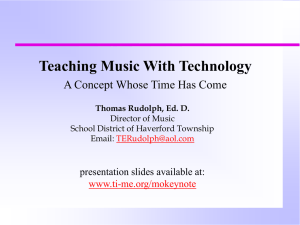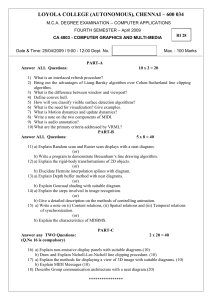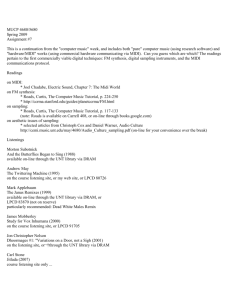Ground-Truth Transcriptions of Real Music from Force-Aligned MIDI Syntheses Abstract
advertisement
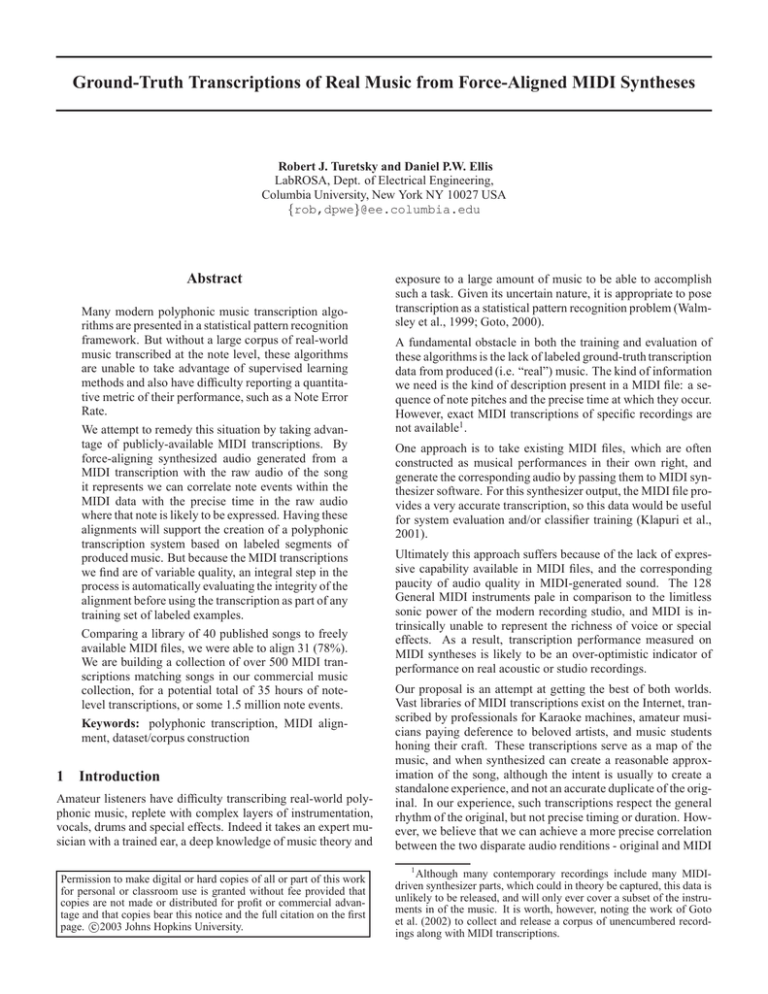
Ground-Truth Transcriptions of Real Music from Force-Aligned MIDI Syntheses
Robert J. Turetsky and Daniel P.W. Ellis
LabROSA, Dept. of Electrical Engineering,
Columbia University, New York NY 10027 USA
{rob,dpwe}@ee.columbia.edu
Abstract
Many modern polyphonic music transcription algorithms are presented in a statistical pattern recognition
framework. But without a large corpus of real-world
music transcribed at the note level, these algorithms
are unable to take advantage of supervised learning
methods and also have difficulty reporting a quantitative metric of their performance, such as a Note Error
Rate.
We attempt to remedy this situation by taking advantage of publicly-available MIDI transcriptions. By
force-aligning synthesized audio generated from a
MIDI transcription with the raw audio of the song
it represents we can correlate note events within the
MIDI data with the precise time in the raw audio
where that note is likely to be expressed. Having these
alignments will support the creation of a polyphonic
transcription system based on labeled segments of
produced music. But because the MIDI transcriptions
we find are of variable quality, an integral step in the
process is automatically evaluating the integrity of the
alignment before using the transcription as part of any
training set of labeled examples.
Comparing a library of 40 published songs to freely
available MIDI files, we were able to align 31 (78%).
We are building a collection of over 500 MIDI transcriptions matching songs in our commercial music
collection, for a potential total of 35 hours of notelevel transcriptions, or some 1.5 million note events.
Keywords: polyphonic transcription, MIDI alignment, dataset/corpus construction
1 Introduction
Amateur listeners have difficulty transcribing real-world polyphonic music, replete with complex layers of instrumentation,
vocals, drums and special effects. Indeed it takes an expert musician with a trained ear, a deep knowledge of music theory and
exposure to a large amount of music to be able to accomplish
such a task. Given its uncertain nature, it is appropriate to pose
transcription as a statistical pattern recognition problem (Walmsley et al., 1999; Goto, 2000).
A fundamental obstacle in both the training and evaluation of
these algorithms is the lack of labeled ground-truth transcription
data from produced (i.e. “real”) music. The kind of information
we need is the kind of description present in a MIDI file: a sequence of note pitches and the precise time at which they occur.
However, exact MIDI transcriptions of specific recordings are
not available1 .
One approach is to take existing MIDI files, which are often
constructed as musical performances in their own right, and
generate the corresponding audio by passing them to MIDI synthesizer software. For this synthesizer output, the MIDI file provides a very accurate transcription, so this data would be useful
for system evaluation and/or classifier training (Klapuri et al.,
2001).
Ultimately this approach suffers because of the lack of expressive capability available in MIDI files, and the corresponding
paucity of audio quality in MIDI-generated sound. The 128
General MIDI instruments pale in comparison to the limitless
sonic power of the modern recording studio, and MIDI is intrinsically unable to represent the richness of voice or special
effects. As a result, transcription performance measured on
MIDI syntheses is likely to be an over-optimistic indicator of
performance on real acoustic or studio recordings.
Our proposal is an attempt at getting the best of both worlds.
Vast libraries of MIDI transcriptions exist on the Internet, transcribed by professionals for Karaoke machines, amateur musicians paying deference to beloved artists, and music students
honing their craft. These transcriptions serve as a map of the
music, and when synthesized can create a reasonable approximation of the song, although the intent is usually to create a
standalone experience, and not an accurate duplicate of the original. In our experience, such transcriptions respect the general
rhythm of the original, but not precise timing or duration. However, we believe that we can achieve a more precise correlation
between the two disparate audio renditions - original and MIDI
1
Permission to make digital or hard copies of all or part of this work
for personal or classroom use is granted without fee provided that
copies are not made or distributed for profit or commercial advantage and that copies bear this notice and the full citation on the first
c
page. 2003
Johns Hopkins University.
Although many contemporary recordings include many MIDIdriven synthesizer parts, which could in theory be captured, this data is
unlikely to be released, and will only ever cover a subset of the instruments in of the music. It is worth, however, noting the work of Goto
et al. (2002) to collect and release a corpus of unencumbered recordings along with MIDI transcriptions.
Figure 1: Goal of MIDI Alignment. The upper graph is the transcription of the first verse of “Don’t You Want Me”, by the Human
League, extracted from a MIDI file placed on the web by an enthusiast. The MIDI file can be synthesized to create an approximation
of the song with a precise transcription, which can analyzed alongside the original song in order to create a mapping between note
events in the MIDI score and the original song, to approximate a transcription.
synthesis - through forced alignment. This goal is illustrated in
figure 1.
In order to align a song with its transcription, we create a similarity matrix, where each point gives the cosine distance between short-time spectral analyses of particular frames from
each version. The features of the analysis are chosen to highlight pitch and beat/note onset times. Next, we use dynamic
programming to find the lowest-cost path between the starts and
ends of the sequences through the similarity matrix. Finally,
this path is used as a mapping to warp the timing of the MIDI
transcription to match that of the actual CD recording.
Because the downloaded MIDI files vary greatly in quality, it is
imperative that we judge the fitness of any alignments that we
plan to use as ground truth transcriptions. Given a good evaluation metric, we could automatically search through thousands
of available MIDI files to find the useful ones, and hence generate enough alignments to create a substantial corpus of real,
well-known pop music recordings with almost complete notelevel transcriptions aligned to an accuracy of milliseconds. This
could be used for many purposes, such as training a robust nonparametric classifier to perform note transcriptions from real audio.
The remainder of this paper is organizes as follows: In section
2 we present the methodology used to create MIDI/raw forced
alignments. Following that is a discussion on evaluation of the
features used and an estimate of the fitness of the alignments.
In the final section, we detail the next steps of this work.
2 Methodology
In this section we describe the technique used for aligning songs
with their MIDI syntheses. A system overview is shown in figure 2. First, the MIDI file is synthesized to create an audio
file (syn). Second, the short-time spectral features (e.g. spectrogram) are computed for both the syn and the original music
audio file (raw). A similarity matrix is then created, providing the cosine distance between each frame i in raw and frame
j in syn. We then employ dynamic programming to search
for the “best” path through the similarity matrix. To improve
our search, we designed a two-stage alignment process, which
effectively searches for high-order structure and then for finegrain details. The alignment is then interpolated, and each note
event in the MIDI file is warped to obtain corresponding onset/offset pairs in the raw audio. Each stage of the process is
described below.
2.1 Audio File Preparation
To begin we start with two files, the raw audio of the song we
wish to align, and a MIDI file corresponding to the song. Raw
audio files are taken from compact disc, and MIDI files have
been downloaded from of user pages found through the MIDI
search engine http://www.musicrobot.com. The MIDI file
is synthesized using WAVmaker III by Polyhedric Software.
Rather than simply recording the output of a hardware MIDI
synthesizer on a sound card, WAVmaker takes great care to ensure that there is a strict correspondence between MIDI ticks
(the base unit of MIDI timekeeping) and samples in the resynthesis. We can move from ticks to samples using the following
conversion:
Ncur = Nbase + Fs · 106 · (Tcur − Tbase )(∆/P P Q)
(1)
where Ncur and Nbase are the sample indices giving current
position and the time of the most recent tempo change, and Tcur
and Tbase are the corresponding times in MIDI ticks. ∆ is the
current tempo in quarters per microsecond, and P P Q is the
division parameter from the MIDI file, i.e. the number of ticks
per quarter note. Fs is the sampling rate.
Both the raw and syn are downsampled to 22.05kHz and normalized, with both stereo channels scaled and combined into a
monophonic signal.
2.2 Feature Calculation
The next step is to compute short-time features for each window
of syn and raw. Since the pitch transcription is the strongest cue
Figure 2: The Alignment Process. Features computed on original audio and synthesized MIDI are compared in the similarity matrix
(SM). The best path through SM is a warping from note events in the MIDI file to their expected occurrence in the original.
for listeners to identify the approximate version of the song, it
is natural that we choose a representation that highlights pitch.
This rules out the popular Mel-Frequency Cepstral Coefficients
(MFCCs), which are specifically constructed to eliminate fundamental periodicity information, and preserve only broad spectral structure such as formants. Although authors of MIDI replicas may seek to mimic the timbral character of different instruments, such approximations are suggestive at best, and particularly weak for certain lines such as voice etc. We use features
based on a narrowband spectrogram, which encapsulates information about the harmonic peaks within a frame. We apply
2048 point (93 ms) hann-windowed FFTs to each frame, with
each frame staggered by 1024 samples (46 ms), and then discard all bins above 2.8 kHz, since they relate mainly to timbre
and contribute little to pitch. As a safeguard against frames consisting of digital zero, which have an infinite vector similarity to
nonzero frames, 1% white noise is added across the spectrum.
In our experiments we have augmented or altered the windowed
FFT in one or more of the following ways (values that we tried
are shown in braces):
1. spec power {‘dB’, 0.3, 0.5, 0.7, 1, 2} - We had initially
used a logarithmic (dB) intensity axis for our spectrogram, but had problems when small spectral magnitudes
become large negative values when converted to dB. In order to approximate the behavior of the dB scale without
this problem, we raised the FFT magnitudes to a power of
spec power. In our experiments we were able to perform
the best alignments by taking the square root (0.5) or raising the spectrum to the 0.7 power.
2. diff points {0, [1 16], [1 64], [224 256]} - First order differences in time of some channels are appended as additional features. The goal here is to highlight onset times
for pitched notes using the low bins and for percussion
using the high bins. In our experiments, we found that
adding the high-bin time differences had negligible effect
because of the strong presence of the snares and hi-hats
across the entire spectrum. Adding low-order bins can im-
prove alignment, but may also cause detrimental misalignment in cases where the MIDI file was transcribed off-key.
3. freq diff {0, 1} - First-order difference in frequency attempts to normalize away the smooth spectral deviations
between the two signals (due to differences in instrument
timbres) and focus instead on the local harmonic structure
that characterizes the pitch.
4. noise supp {0, 1} - Noise suppression. Klapuri has proposed a method for simultaneously removing additive and
convolutive noise through RASTA-style spectral processing (Klapuri et al., 2001). This method was not as successful as we had hoped.
2.3 The Similarity Matrix
Alignment is carried out on a similarity matrix (SM), based
on the self-similarity matrix used commonly in music analysis (Foote, 1999), but comparing all pairs of frames between
two songs, instead of comparing one song against itself. We
calculate the distance between each time step i (1 . . . N ) in the
raw feature vector series specraw with each point j (1 . . . M )
in the syn series specsyn . Each value in the N × M matrix is
computed as follows:
SM (i, j) =
specraw (i)T specsyn (j)
,
|specraw (i)||specsyn (j)|
for 0 ≤ i < N,
0≤j<M
(2)
This metric is proportional to the similarity of the frames, e.g.
similar frames have a value close to 1 and dissimilar frames
have a value that can approach -1. Several similarity matrices for different songs are shown in figure 4, in which we can
see the structures that are also present in self-similarity matrices, such as the checkerboard pattern corresponding to segment
boundaries, and off-diagonal lines signifying repeated phrases
Bartsch and Wakefield (2001); Dannenberg and Hu (2002). The
presence of the strong diagonal line indicates a good alignment
between the raw and syn files, and the next stage attempts to
find this alignment.
2.4 Alignment
2.5 Interpolation
The most crucial stage in the process of mapping from MIDI
note event to raw audio sample is searching for the “best path”
through the similarity matrix. This is accomplished with dynamic programming or DP (Gold and Morgan, 1999), tracing
a path from the origin to (N − 1, M − 1). DP is used in
many applications, ranging from the Dynamic Time Warp used
in speech recognition, through to aligning closely-related sequences of DNA or amino acids in bioinformatics.
Once alignment is complete, we can treat the best path as a
warping function between syn samples and raw samples. In order to achieve sub-frame resolution, the best path is linearly interpolated and smoothed across multiple alignment frame pairs.
To demonstrate the warping by the best path, we created two
sets of stereo resyntheses with raw in one ear against syn in
the other. The first simply plays each frame of raw/syn along
the best path, without taking too much care to smooth transitions between discontiguous frames. The second plays the
unmodified raw in one channel, and MIDI synthesis based
on the time-warped MIDI notes in the other. These examples are available at the MIDIAlign project webpage, http:
//www.ee.columbia.edu/˜rob/midialign/.
DP consists of two stages, forward and traceback. In the forward step, we calculate the lowest-cost path to all of the point’s
neighbors plus the cost to get from the neighbor to the point in this case, Smax − SM (i, j), where Smax is the largest value
in the similarity matrix. This makes the cost for the most similar frame pairs be zero, and all other frame pairs have larger,
positive costs. The object of this stage is to compute the cost of
the best path to point (N − 1, M − 1) recursively by searching
across all allowable predecessors to each point and accumulating cost from there. In the traceback stage, we find the actual
path itself by recursively looking up the point providing the best
antecedent for each point on the path.
We have experimented with of two complementary flavors of
DP, which we have dubbed “unconstrained” and “greedy”. Figure 3 demonstrates this on a small scale, using the alignment of
a three note sequence. Panels (a) and (d) show the freedom of
movement allowed in each configuration; in our DP, all allowed
steps have equal weight. Panels (b) and (e) show the DP when
the transcription of the sequence is correct, and the third column
shows the behavior of the DP when the MIDI transcription has
the second and third notes swapped.
Unconstrained DP (top row) allows the best path to include
horizontal and vertical segments, thus allowing it to skip entire regions of original or resynthesis. When searching for the
lowest-cost path on a SM that penalizes dissimilar frames, unconstrained DP is capable of bypassing extraneous segments
such as repeated verses or mis-transcribed notes. However, in
terms of fine-grained structure, its performance is weak, since
it may include short horizontal or vertical regions within individual notes when certain frame pairs align particularly well.
Greedy DP (bottom row), on the other hand, enforces forward
motion by at least one frame on both axes at every step. This
behavior results in smooth structure when the notes are correctly transcribed; however, in the presence of errors, the greedy
method will still find a convincing-looking roughly-diagonal
path even when no good one exists (panel (f) of figure 3).
2.4.1 Two-stage Alignment
We developed a two stage alignment process exploiting the
complementary DP flavors. In the first stage, we use unconstrained DP to discover the regions of the song which appear
likely to align well, and to skip regions that contain no good
diagonal paths. We then apply a 31-point (1.4 s) median filter
across the slope of the best path found by unconstrained DP. The
median filter searches for contiguous regions in which the majority of steps are diagonal, as these segments are most likely
able to be aligned rather than skipping over misalignments.
Straight segments of any significant length become boundaries,
and greedy DP is applied in between them to re-align these
‘good’ segments more accurately.
3 Featureset and Alignment Evaluation
The primary objective of these alignments is to create a large set
of transcribed real-world polyphonic music. Given the murky
origins of many of the MIDI files we encounter, there are alignments that, simply put, do not work; figure 4 gives four example
alignments, illustrating some of the problems we encountered.
While the alignment algorithm is tolerant of missing sections
and a certain amount of ornamentation or interpretation, other
errors will defeat it completely. We have encountered transcriptions that are transposed, with segments transcribed out of order, of a different remix/version of the song, or which are simply
abysmal. Our web crawling has uncovered MIDI transcriptions
for thousands of songs, with a handful of different versions for
each, and hence the importance of an automatic metric to discriminate the successful alignments cannot be overstated.
3.1 Evaluation of featuresets
In order to evaluate different candidate metrics, we first computed the alignment for 7 different featuresets on each of the 40
songs in our corpus. The songs were chosen to include some
variety in terms of different types of popular music, and not because of the quality of their transcriptions. We then manually
evaluated 560 alignments, two for each feature for each song
corresponding to the best path found by the first and second
stages. Manual evaluation was our only choice, initially, since
we had no ground truth available of time-point correspondences
between original recordings and their MIDI renditions. Listening to the aligned resyntheses was considered less arduous than
annotating the set of music to create this ground truth. We aurally evaluated the rendered comparisons on the following scale:
Note that this score encapsulates both the performance of the
algorithm and the quality of the transcription. The Count column is the number of songs that reached this level of evaluation
as the highest score across all of the features. Thus, for 31 of
the 40 MIDI/raw pairs, our automatic alignment gave us at least
one perfect or near-perfect alignment. These could be extracted
and used as a manually-verified ground truth for further alignment experiments, although we have not used them this way as
yet. They are of course by definition the examples on which
automatic analysis is most likely to succeed.
We can use these annotations to determine which featureset is
most effective. Table 2 charts each featureset that we’ve used
vs. the number of occurrences of each subjective quality label
for alignments based on that featureset. From the table, it can
Unconstrained
(a)
(c)
(e)
(f)
Greedy
(d)
(b)
Figure 3: Flavors of DP. The top row is for unconstrained DP, the bottom row is for greedy. The first column shows the allowable
directions of movement. The second column shows the alignment of raw/MIDI notes C5-C5-D5, for unconstrained and greedy
respectively. The third column shows the alignment of raw as before, but with the last two notes of MIDI reversed.
(a)
Alignment: Don't You Want Me - Human League
(b)
Alignment: Africa - Toto
500
1000
1000
1500
2000
RAW frames
RAW frames
2000
2500
3000
3000
4000
3500
4000
5000
4500
6000
5000
(c)
500 1000 1500 2000 2500 3000 3500 4000 4500 5000
SYN frames
Alignment: Temple of Love - Sisters of Mercy
(d)
1000
500 1000 1500 2000 2500 3000 3500 4000 4500 5000
SYN frames
Alignment: 9pm Till I Come - ATB
500
2000
1000
1500
4000
RAW frames
RAW frames
3000
5000
6000
7000
2000
2500
3000
8000
3500
9000
4000
10000
500
1000 1500 2000 2500 3000 3500 4000 4500 5000
SYN frames
500
1000
1500
2000 2500
SYN frames
3000
3500
4000
Figure 4: Example alignments for four SMs: (a) Don’t You Want Me (Human League): straightforward alignment; (b) Africa
(Toto): bridge missing in transcription; (c) Temple of Love (Sisters of Mercy): Transcription out of order but we recover; (d) 9pm
’Till I Come (ATB): poor alignment mistakenly appears successful. White rectangles indicate the diagonal regions found by the
median filter and passed to the second-stage alignment.
Score
1
2
3
4
5
Interpretation
Could not align anything. Not for
use in training.
Some alignment but with timing
problems, transposition errors, or
a large number of misaligned sections.
Average alignment. Most sections
line up but with some glitching. Not
extremely detrimental to training,
but unlikely to help either.
Very good alignment. Near perfect,
though with some errors. Adequate
for training.
Perfect alignment.
Count / 40
4
2. Average Best Path Percentile - The average similarity score
of pairs included in the best path, expressed as a percentile
of all pair similarity scores in the SM. By expressing this
value as a percentile, it is normalized relative to the actual variation (in range and offset) of similarities within
the SM.
2
3
4
27
Table 1: Subject alignment assessment. Different versions of
MIDI syntheses aligned to original audio were auditioned in
stereo against the original recording, and given a score from 1
to 5, indicating the combined quality of the original MIDI file
and the alignment process.
Featureset
spec power = 0.5
spec power = 0.7
spec power = 1.0
spec power = 0.7 diff points [1 16]
spec power = 0.7 diff points [1 64]
spec power = 0.7 freq diff = 1
spec power = 0.7 noise supp = 1
1
6
6
6
5
6
7
28
2
2
3
4
6
7
5
1
Score
3
7
4
13
4
0
6
0
4
6
10
5
11
4
11
1
be reflected in this value, without necessarily indicating a
weak alignment.
5
15
14
9
13
21
4
0
Table 2: Feature Evaluation. Above is a representative list of
featuresets which were applied to alignment on our corpus of
music. Columns 1 through 5 indicate the number of songs evaluated at that score for that featureset. Alignments rated 4 or 5
are considered suitable for training.
be seen that spec power = .5 or .7 and its variants lead to the
most frequent occurrence of good alignments, with the highest
incidence of alignments rated at “5” for spec power = .7 and
diff points = [1 64].
3.2 Automatic Alignment Evaluation
Given the high costs on the attention of the subject to obtain the
subjective alignment quality evaluations,our goal is to define a
metric able automatically to evaluate the quality of alignments.
Our subjective results bootstrap this by allowing us to compare
those results with the output of candidate automatic measures.
In order to judge the fitness of an alignment as part of a training
set, we have experimented with a number of metrics to evaluate
their ability to discriminate between good and bad alignments.
They are:
1. Average Best Path Score - The average value of SM along
the best path, in the diagonal regions found by the median
filter. MIDI resyntheses that closely resemble the originals will have a large number of very similar frames, and
the best path should pass through many of these. However, sources of dissimilarity such as timbral mismatch will
3. Off-diagonal Ratio - Based on the notion that a good alignment chooses points with low cost among a sea of mediocrity while a bad alignment will simply choose the shortest path to the end, the off-diagonal ratio takes the average
value of SM along the best path and divides it by the average value of a path offset by a few frames. It is a measure
of the ‘sharpness’ of the optimum found by DP.
4. Square Ratio - The ratio of areas of the segments used in
second stage alignment (corresponding to approximately
linear warping) as a proportion of the total area of the SM.
First stage alignments that deleted significant portions of
either version will reduce this value, indicating a problematic alignment.
5. Line Ratio - The ratio of the approximately linear segments
of the alignment
√ versus the length of the best path, i.e. approximately SquareRatio.
Our experiments have shown that the metric 2, the average best
path percentile, demonstrates the most discrimination between
good and bad alignments. When automatically evaluating a
large corpus of music, it is best to use a pessimistic evaluation
criterion, to reduce false positives which can corrupt a training
set. Figure 5 shows example scatter plots of automatic quality
metric versus subjective quality rating for this metric with two
different feature bases; while no perfect threshold exists, it is at
least possible to exclude most poor alignments while retaining
a reasonable proportion of good ones for the training set.
4 Discussion and conclusions
Although we are only at the beginning of this work, we intend
in the immediate future to use this newly-labeled data to create note detectors via supervised, model-free machine learning
techniques. Given the enormous amount of MIDI files available
on the web, it is within the realm of possibility to create a dataset
of only the MIDI files that have near-exact alignments. We can
then note-detecting classifiers based on these alignments, and
compare these results with other, model-based methods.
Additionally, we are investigating better features for alignment and auto-evaluation. One such feature involves explicitly searching for overtones expected to be present in the raw
given an alignment. Another method for auto-evaluation is to
use the transcription classifiers that we will be creating to retranscribe the training examples, pruning those whose MIDI
and automatic transcriptions differs significantly.
Since MIDI transcriptions only identify the attack and sustain
portion of a note, leaving the decay portion that follows the
‘note off’ event to be determined by the particular voice and
other parameters, we will need to be careful when training note
detectors not to assume that frames directly following a note off
5
4
3
2
1
55
Avg. Best Path Percentile:
spec power 0.7 - diff points [1 64]
Alignment Ranking
Alignment Ranking
Avg. Best Path Percentile:
spec power 0.7
60
65
70 75 80 85 90
Best Path Percentile
95 100
5
4
3
2
1
55
60
65
70 75 80 85 90
Best Path Percentile
95 100
Figure 5: Comparison between subjective and automatic alignment quality indices for the average best path percentile, our most
promising automatic predictor of alignment quality. Shown are equal risk cutoff points for two good-performing featuresets, with
good alignments lying to the right of the threshold.
do not contain any evidence of that note. Of course, our classifiers will have to learn to handle reverberation and other effects
present in real recordings.
There is also a question of balance and bias in the kind of training data we will obtain. We have noticed a distinct bias towards
mid-1980s pop music in the available MIDI files: this is the
time when music/computer equipment needed to generate such
renditions first became accessible to a mass hobbyist audience,
and we suspect many of the files we are using date from that
initial flowering of enthusiasm. That said, the many thousands
of MIDI files available online do at least provide some level of
coverage for a pretty broad range of mainstream pop music for
the past several decades.
Given that the kind of dynamic time warping we are performing is best known as the technique that was roundly defeated
by hidden Markov models (HMMs) for speech recognition, it is
worth considering whether HMMs might be of some use here.
In fact, recognition with HMMs is very often performed using
“Viterbi decoding”, which is just another instance of dynamic
programming. The main strength of HMMs lies in their ability to integrate (through training) multiple example instances
into a single, probabilistic model of a general class such as a
word or a phoneme. This is precisely what is needed in speech
recognition, where you want a model for /ah/ that generalizes
the many variations in your training data, but not at all the case
here, where we have only a single instance of original and MIDI
resynthesis that we are trying to link. Although our cosine distance could be improved with a probabilistic distance metric
that weighted feature dimensions and covariations according to
how significant they appear in past examples, on the whole this
application seems perfectly suited to the DTW approach.
Overall, we are confident that this approach can be used to generate MIDI transcriptions of real, commercial pop music recordings, mostly accurate to within tens of milliseconds, and that
enough examples are available to produce as much training data
as we are likely to be able to take advantage of, at least for the
time being. We anticipate other interesting applications of this
corpus, such as convenient symbolic indexing into transcribed
files, retrieval of isolated instrument tones from real recordings,
etc. We welcome any other suggestions for further uses of this
data.
Acknowledgments
Our thanks go to the anonymous reviewers for their comments
which were very helpful.
References
Bartsch, M. A. and Wakefield, G. H. (2001). To catch a chorus:
Using chroma-based representations for audio thumbnailing. In
Proc. IEEE Workshop on Applications of Signal Processing to
Audio and Acoustics, Mohonk, New York.
Dannenberg, R. and Hu, N. (2002). Pattern discovery techniques for music audio. In Fingerhut, M., editor, Proc. Third International Conference on Music Information Retrieval ISMIR02, pages 63–70, Paris. IRCAM.
Foote, J. (1999). Methods for the automatic analysis of music
and audio. Technical report, FX-PAL.
Gold, B. and Morgan, N. (1999). Speech and Audio Signal Processing: Processing and Perception of Speech and Music. John
Wiley & Sons, Inc., New York.
Goto, M. (2000). A robust predominant-f0 estimation method
for real-time detection of melody and bass lines in cd recordings. In IEEE International Conference on Acoustics, Speech
and Signal Processing ICASSP-2000, pages II–757–760, Istanbul.
Goto, M., Hashiguchi, H., Nishimura, T., and Oka, R. (2002).
Rwc music database: Popular, classical, and jazz music
databases. In Fingerhut, M., editor, Proc. Third International
Conference on Music Information Retrieval ISMIR-02, Paris.
IRCAM.
Klapuri, A., Virtanen, T., Eronen, A., and Seppänen, J. (2001).
Automatic transcription of musical recordings. In Proceedings
of the CRAC-2001 workshop.
Walmsley, P. J., Godsill, S. J., and Rayner, P. J. W. (1999).
Bayesian graphical models for polyphonic pitch tracking. In
Proc. Diderot Forum.
